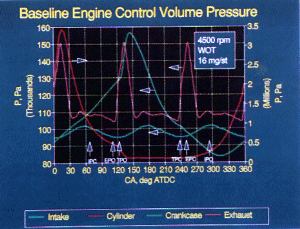|
Two-stroke engines, with their small size and
mechanical simplicity, provide unique benefits to engine designers,
manufacturers, and users. Although they were gradually abandoned for automotive
use during the 1960s because of seemingly insurmountable emissions problems, new
technology such as cost-effective in-cylinder fuel injection offers promise for
their resurgence.
Development of automotive two-stroke engines must
address:
- Piston scuffing
- Ring wear
- Oil consumption
- Starting
- Idling
- Scavenging
Southwest Research Institute (SwRI), with more than
40 years of engine, fuel, lubricant, and vehicle research experience, has
developed analytical and experimental techniques to quantify and solve problems
associated with automotive two-stroke engines.
Ring Motion Modeling and Measurement
A combination of computer analyses, real-time oil
consumption calculations, and blowby measurements is used to determine the cause
of excessive oil consumption, blowby, and ring wear.
Highly developed models predict piston ring force
balances (ring friction, cylinder pressure, ring geometry, and weight). The
models provide new understanding of piston ring motion characteristics and
facilitate design optimization for minimum oil consumption and blowby.
 |
Test piston is fitted with special
electrically insulated ring grooves and a radio transmitter to monitor
ring motion.
|
Ring motion measurement techniques, with telemetry
similar to that utilized in piston temperature measurement, are used to
supplement analyses.
Piston Temperature Telemetry
SwRI developed a self-powered, telemetry-based device
for measuring engine piston temperature. The key component is the power
generator, which uses piston acceleration forces to move a steel slug through a
magnetic field, generating alternating current. Power is rectified and filtered
to supply transmitter and sensor circuitry. Capacitive sensors are multiplexed
to an oscillator that transmits temperature data as an RF signal to an antenna
in the engine sump.
The resulting package, which has been tested at
temperatures to 600 degrees F and engine speeds in excess of 5,000 rpm, is small,
lightweight, and non-intrusive.
 |
A piston is instrumented to measure
seven temperatures simultaneously in a turbocharged engine. The SwRI
piston temperature telemetry system was recognized by R&D
Magazine as one of the top 100 technological developments of 1991.
|
Real-Time Oil Consumption Measurement
A specially blended oil containing thermally
stabilized sulfur is used, along with a sulfur-free fuel, in a real-time oil
consumption measurement technique developed at the Institute. Continuous
measurement of sulfur dioxide in the exhaust allows calculation of the oil
consumption rate, and special sampling procedures are used to differentiate
burned and unburned fractions.
The sulfur tracer technique replaces time-consuming
oil weighing procedures. An entire matrix of engine speeds and loads can be
mapped in one day with the sulfur tracer technique.
Real-Time Wear Measurement
Internal combustion engine component wear is
monitored in situ on a near real-time basis using surface layer
activation (SLA) techniques. SLA involves activating a thin layer on the wear
component, then installing the activated component in a test engine. Activity
levels are relatively small when compared to classical tracer techniques. The
gamma-ray activity level of the component is monitored using a conventional
sodium-iodide scintillation detector. The reduction in activity concentration is
corrected for the half-life decay of the selected isotope, then correlated with
a calibrated wear activity profile to determine wear over a given time period.
Combustion Investigation
Noise, vibration, and harshness (NVH) are significant
issues facing engine developers. Idle and light load combustion roughness are
important elements of NVH.
In a novel and robust design adaptable to production
engines, an optical spark plug probe and a head gasket ionization probe are
being combined to facilitate the study of early flame kernel development,
growth, and completion of combustion.
 |
Spark plug is modified with eight
fiber optic probes to observe the passage of early flame development.
|
Because cycle-to-cycle data are obtained, the
technology is particularly well suited to characterize cold-start cycle
variability, misfire, stall, and idle roughness.
The effects of spark energy, air motion, turbulence,
and EGR on flame development are readily determined using this technology.
Fuel Spray Characterization
SwRI has the facilities and experience to
characterize and develop injection equipment. Laser diffraction and
phase-Doppler drop size and velocity measuring equipment, high speed video and
cinematography, phase discrimination probes, and high pressure bombs are
available for detailed investigations of global spray development, spatial
distribution of drop size, liquid mass fractions, and degree of vaporization.
SwRI has expertise in the design and development of
many types of fuel injection and fuel control systems (conventional fuels,
alternative liquid fuels, and gaseous fuels, both with and without air-assisted
injection).
Heating fluids dramatically improves
atomization in a standard automotive injector. SwRI researchers are
investigating possible improvements in starting and cold-start emissions
with fine fuel sprays.
|
External Scavenge Systems
A spherical air pump designed by Institute engineers
displaces almost its entire internal volume with each revolution, making it very
attractive as a scavenge pump for two-stroke engines. High internal volume
utilization offers potential for a package one-third to one-half the size of
conventional blowers.
The pump can be designed to optimize the trade-off
between internal compression ratio and volumetric efficiency, depending on the
air delivery strategy chosen for the engine at various operating conditions.
Computer Modeling
SwRI developed a multicylinder computer program to
provide a means for comparing various two-stroke engines and optimizing design
parameters. The program facilitates the process of investigating design
variables such as port geometry and pipe length over specified ranges and
determining their influences on key performance parameters, including power,
fuel consumption, and mass of air throughflow. The program is easy to use and
allows setup of nested parametric cases.
The SwRI program is used to simulate
crankcase-scavenged or externally scavenged engines, and custom features can be
added as needed. Dynamic pressure wave propagation is simulated in the intake
and exhaust systems, which can be made up of complex networks of pipe segments
and junctions.
 |
Engine modeling program output
indicates crankcase, transfer port, and manifold pressures for a
three-cylinder engine.
|
|